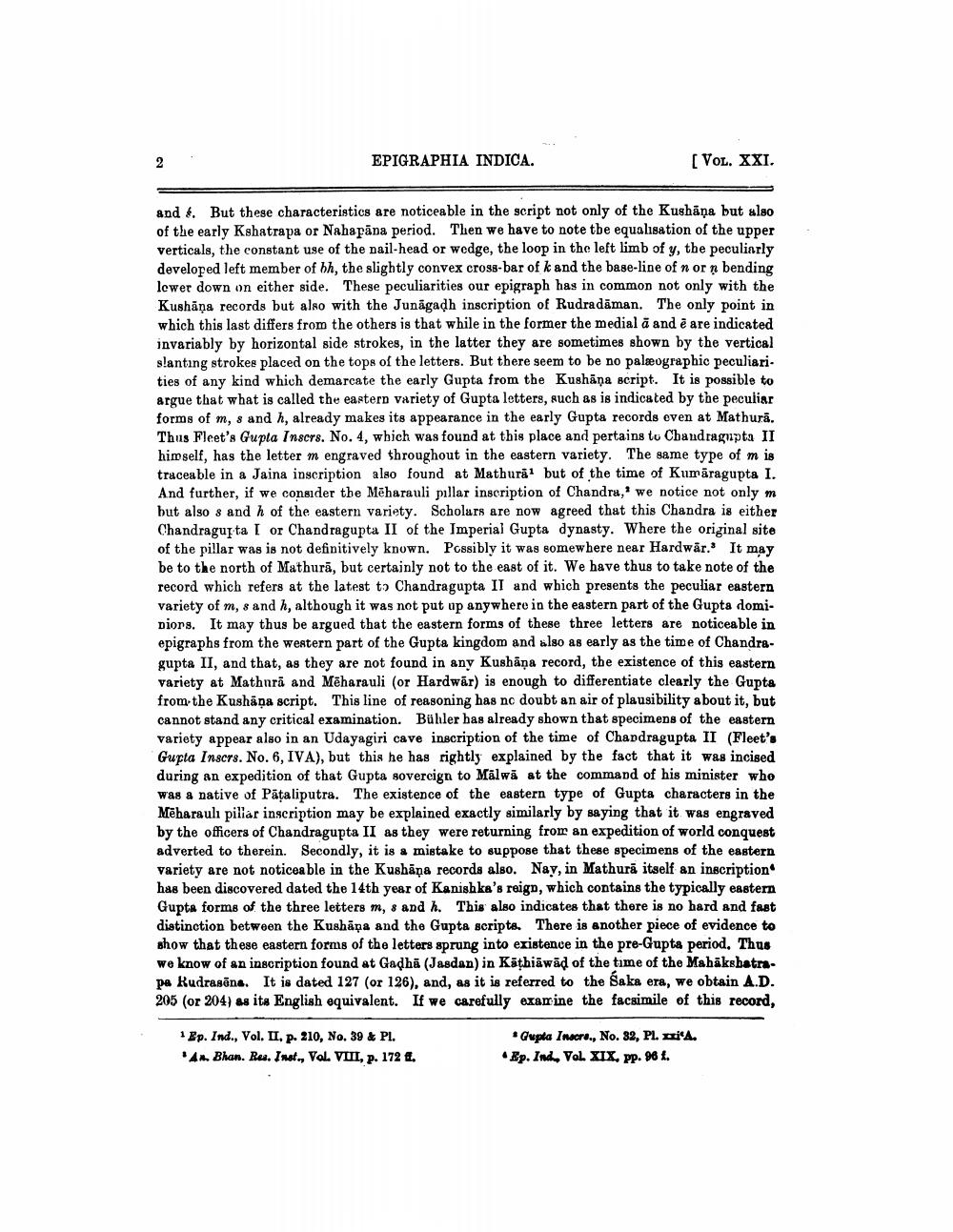________________
EPIGRAPHIA INDICA.
[VOL. XXI.
and 6. But these characteristics are noticeable in the script not only of the Kushäņa but also of the early Kshatrapa or Nahapāna period. Then we have to note the equalisation of the upper verticals, the constant use of the nail-head or wedge, the loop in the left limb of y, the peculiarly developed left member of bh, the slightly convex cross-bar of k and the base-line of n or bending lower down on either side. These peculiarities our epigraph has in common not only with the Kushāņa records but also with the Junagadh inscription of Rudradāman. The only point in which this last differs from the others is that while in the former the medial a and è are indicated invariably by horizontal side strokes, in the latter they are sometimes shown by the vertical slanting strokes placed on the tops of the letters. But there seem to be no palæographic peculiarities of any kind which demarcate the early Gupta from the Kushāna script. It is possible to argue that what is called the eastern variety of Gupta letters, such as is indicated by the peculiar forms of m, s and h, already makes its appearance in the early Gupta records even at Mathurā. Thus Fleet's Gupta Inscrs. No. 4, which was found at this place and pertains tu Chandragupta II himself, has the letter m engraved throughout in the eastern variety. The same type of mis traceable in a Jaina inscription also found at Mathurai but of the time of Kumāragupta I. And further, if we consider the Mēharauli pillar inscription of Chandra,' we notice not only m but also & and h of the eastern variety. Scholars are now agreed that this Chandra is either Chandragupta I or Chandragupta II of the Imperial Gupta dynasty. Where the original site of the pillar was is not definitively known. Possibly it was somewhere near Hardwar. It may be to the north of Mathurā, but certainly not to the east of it. We have thus to take note of the record which refers at the latest to Chandragupta II and which presents the peculiar eastern variety of m, & and h, although it was not put up anywhere in the eastern part of the Gupta domiDiors. It may thus be argued that the eastern forms of these three letters are noticeable in epigraphs from the western part of the Gupta kingdom and also as early as the time of Chandragupta II, and that, as they are not found in any Kushāņa record, the existence of this eastern variety at Mathurā and Mēharauli (or Hardwar) is enough to differentiate clearly the Gupta from the Kushäņa script. This line of reasoning has no doubt an air of plausibility about it, but cannot stand any critical examination. Bühler has already shown that specimens of the eastern variety appear also in an Udayagiri cave inscription of the time of Chapdragupta II (Fleet's Gupta Inscrs. No. 6, IVA), but this he has rightly explained by the fact that it was incised during an expedition of that Gupta sovereign to Mālwa at the command of his minister who was a native of Pataliputra. The existence of the eastern type of Gupta characters in the Méharauli pillar inscription may be explained exactly similarly by saying that it was engraved by the officers of Chandragupta II as they were returning from an expedition of world conquest adverted to therein. Secondly, it is a mistake to suppose that these specimens of the eastern variety are not noticeable in the Kushāņa records also. Nay, in Mathurā itself an inscription has been discovered dated the 14th year of Kanishka's reign, which contains the typically eastern Gupta forms of the three letters m, 8 and h. This also indicates that there is no hard and fast distinction between the Kushāpa and the Gupta scripts. There is another piece of evidence to show that these eastern forms of the letters sprung into existence in the pre-Gupta period. Thus we know of an inscription found at Gadhā (Jasdan) in Kāthiāwād of the time of the Mabākshatrapa Rudrasēna. It is dated 127 (or 126), and, as it is referred to the Saka era, we obtain A.D. 205 (or 204) as its English equivalent. If we carefully examine the facsimile of this record,
1 Ep. Ind., Vol. II, p. 210, No. 39 & Pl. Am Bhan. Res. Inst., Vol. VIII, p. 172 4.
* Gupta Inacro., No. 32, Pl. mi'A. • Ep. Ind. Vol. XIX. pp. 96 L.




